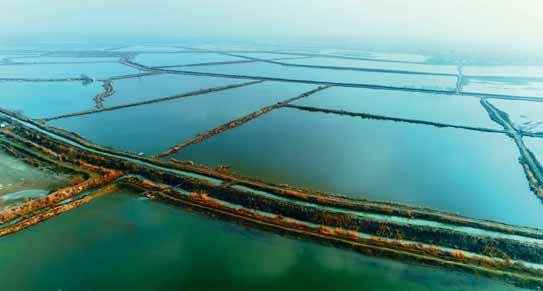
23 minute read
European expertise in farming and processing could benefi t the sector in Uzbekistan
by Eurofish
Ambitious strategy charts out aquaculture development
Fish production in the Republic of Uzbekistan comes primarily from inland capture fi shing and fi sh farming. The latter is mainly the extensive pond production of silver carp and common carp, but plans are afoot to expand this to other species using waterconserving technologies.
Advertisement
Uzbekistan is a landlocked country situated in the middle of Central Asia and has an area of about 450,000 sq. km. Th e country has a typical inland climate with marked seasonal temperature fl uctuations, i.e. hot summers and cold winters. Th e average temperature in summer is about 27 °C often rising to more than 40 °C in the daytime, while the average temperature in February is -6 to -8 °C.
Better care of water resources would increase sector potential
Th ere are more than 500 rivers in Uzbekistan, most of them in the mountainous part of the country. Th e most water-abundant is the Amu Darya, 1,140 km long, with a fl ow of 78 km 3 /year; the Syr Darya is 2,140 km long and has a fl ow of 36 km 3 /year. Th ere is a well-developed network of irrigation (150,000 km) and drainage (100,000 km) canals and collectors. Irrigation has regulated all the rivers in the basin and changed all the natural reservoirs, especially in the plains; a network of water storage lakes has been formed, some of which have become major fi shery basins. However, natural basins tend to accumulate polluted water containing salts, hydrogen sulphide, ammonia, and free carbon Ponds in Kuyi Chirchik Region of Tashkent Oblast (region).
dioxide, from agriculture runoff and industrial discharges. Th is causes an oxygen defi ciency preventing development of the natural food supply which interferes with normal fi sh growth.
Th e total salt content of the water from these sources varies from 0.6 to 6.3 grams/litre, and it is many times higher in drainage water reservoirs (lakes). Together with an acute shortage of water during the growing season (summer), it slows down the growth rate of the fi sh and leads to a decrease in commercial catches of valuable fi sh species. While the mountainous part of the country is rich in streams, there are only 4 rivers in the plains – the Amy Darya and Syr Darya and the less water-bearing Zarafshan and Kashka Darya. Th e fl ow of all these rivers has been fully regulated for irrigation purposes. Uzbekistan’s agricultural sector is based almost entirely on irrigation. It is the largest water consumer in the Aral Sea basin, where agriculture has driven the development of irrigation systems.
Association represents companies all along the value chain
Uzbekbaliksanoat Association was established in 2017 in response to legislation enacted to develop fi shery management systems, improve
fi sh breeding, and increase fi shing companies’ productivity. As of today, more than 1,200 companies are members of the association. Th ey specialise in fi sh culture, harvesting, processing, production of pelletized fi sh feed, and sale of fi sh products. Th e association has been working on scaling up fi sh production, which grew from 65,300 tonnes in 2016 to 84,000 tonnes in 2017, 94,100 tonnes in 2018, and in 2019 is expected to exceed 100,000 tonnes. However, annual fi sh consumption in Uzbekistan is under 3 kg of fi sh per capita while the recommended fi gures are 10-11 kg and the consumption potential in the country is 16-18 kg.
Trout ponds in Namangan District.
Until recently, the only type of aquaculture in Uzbekistan was carp polyculture in large earthen ponds, where productivity reaches 1,500 to 2,000 kilograms per hectare and 2,000 – 3,000 kg if optimised. However, this extensive technology has serious disadvantages: fi rst the ponds must be fi lled with water in spring, the water level has to be maintained during summer, and then the ponds must be drained for harvesting in autumn. Water is thus removed from the source for the whole season and never used for any other purpose. More than 22,000 cubic meters of water are removed to fi ll one hectare of a 1.5-meterdeep pond — while there is a severe defi cit of both water resources and irrigated land in Uzbekistan. One of the main requirements of both the agriculture and fi shery sectors is an assessment of their needs for water. Th is information will lay the foundation for the development of new water-saving technologies.
Low water consuming production systems increase in popularity
OOO DB FISH Group

been introduced with good results. Using this method 20 to 30 tonnes per hectare are being produced at a private fi sh farm, Valley Fish, in Andizhan Oblast. More than 20 similar systems are also operating in Tashkent, Navoiy, Xorazm, Surkhandarya and Andizhan Oblasts, and there are plans to further expand the use of this technology. Th e share of production in intensive systems (tanks, recirculation aquaculture systems, net cages) has grown from 1,545 tonnes (1.8 of the total aquaculture production) in 2017 to 7,600 tonnes (8.1) in 2018 and is expected to exceed 15,000 tonnes (10) in 2019. Water scarcity and the lack of sites to construct new ponds in irrigated areas make water-saving projects attractive. More than 20 projects have been chosen throughout the country to build capacities (8,000 tonnes) for growing trout, salmon and sturgeon in foothill areas. Th ese projects will be implemented over the next fi ve years using the experience of Golden Fish Group Ltd, a company with expertise in cold water fi sh culture based in Tashkent Oblast.
Fish cultured in man-made ponds (38,000 ha) amounts to 64 of the total production; the share of production from natural reservoirs (565,000 ha) is 25-26 including 8-10 of trash fi sh used for nonfood processing; fi nally 8-10 of fi sh is cultured in intensive systems. Diversity of fi sh species is comparatively poor in Uzbekistan with under 100 species in natural reservoirs and only 20 to 22 of them of commercial interest. Aquaculture provides 7 to 8 fi sh species.
Resources for fi sh cultivation in Uzbekistan
Water bodies Location Area (ha) Natural fi shery basins total 565,000 Artifi cial earth ponds total 38,000 Largest lake systems Aydar-Arnasay Lower Syr Darya river 370,000 Zheltyrbas 17,200 Sudochye 19,000 Mezdurechye-Kuksu Lower Amu Darya and Zarafshan rivers 12,300 Karakir 12,000 Ayak Agitma 8,000
Main sources of Uzbekistan's imports of fi sh and seafood
Country Value (USD) Proportion of total value (%) Product Viet Nam 1,542,200 21 Pangasius fi llets, shrimp Norway 1,525,100 20 Atlantic salmon fi llets Lithuania 1,361,000 18 Canned fi sh Russia 1,164,500 15 Alaska pollock fi llets Latvia 870,000 11 Canned fi sh, trout fi llets Other 1,237,200 15 Total 7,700,000 100
Cold-water fi sh farm, Golden Fish Group Ltd in Tashkent Oblast. Feeding sturgeons at the Fishery Research Institute in Tashkent Oblast.

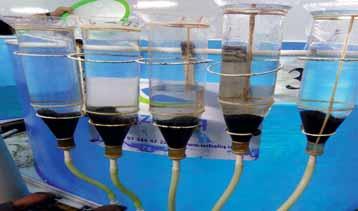
Th e volume of aquaculture production of some fi sh species, like silver carp, is 1.5 to 2 times the demand. Th ere is strong competition among carp producers, which results a plentiful supply of common carp and silver carp weighing 700 g to 2 kg at very reasonable prices. Common carp and silver carp production in extensive ponds systems and the introduction of common carp and African catfi sh culture in tanks and net cages keep prices for these species at a stable level. Local consumers prefer fi sh of 1.5 kg or more, but it takes 1.5 to 2 years to grow fi sh to this size.
Range of locally produced fi sh products is limited
Th e assortment of species caught in natural reservoirs include roach, bream, snakehead, zander, common carp, Georgian shemaya (Alburnus derjugini), goldfi sh among others. While common carp, silver carp, African catfi sh and some lake species are supplied both live and chilled in suffi cient volume, valuable species like tilapia, sturgeon, trout, and salmon are scarce on the market. Fish imports in 2018 amounted to 4,090 tonnes worth USD7.7 million and the main imported products were salmon, Alaska pollock and pangasius fi llets, canned fi sh, and small volumes of smoked fi sh. Fish exports in 2018 were worth USD2.1 million and comprised mainly zander fi llets. Fish processing in Uzbekistan is a relatively recent activity. Th e company, Xorazm Balik Sanoat Agro started producing canned fi sh (2 million pcs) in Xorazm Oblast and is building another factory with a capacity of 9 million pcs in Muynak Region of the Republic of Karakalpakstan (an autonomous republic within Uzbekistan).
Much work has been done in the country to improve education in the fi sheries sector. Seven higher educational establishments (Tashkent Agrarian University, Nukus Branch of the Agrarian Institute, Samarkand Veterinary Institute, Uzbek National University, Bukhara, Namangan, and Fergana State Universities) educate personnel for the industry. Twenty-six masters, 98 full-time bachelors and 115 distant education bachelors will soon join the ranks of fi sh breeding specialists and researchers at fi shery research institutes. Th e Fishery Research Institute under the State Committee for Veterinary and Livestock Development conducts research in the fi eld of intensive aquaculture development. Uzbekbaliksanoat Association funded the laboratory for new aquaculture technologies hosted by the institute. Easy Fish, a domestic company producing aquaculture equipment, also contributed to the establishment of the laboratory, which is fully supplied with modern equipment. Here, researchers implement projects on the acclimatisation of promising fi sh species in Uzbekistan; study reproductive behaviour of local fi sh species; develop artifi cial breeding methods; and experiment with feeding technologies using recipes containing local ingredients.
Comprehensive ten-year strategy includes rearing of cold water species
Th e association has developed a strategy for the development of the fi shery industry by the year of 2030. Th e strategy aims to strengthen food security by increasing fi sh production using water-saving industrial technologies. In addition, the strategy envisages the:
r development of pond breeding technology for local fi sh species, their reproduction, genetic selection, and restocking; r introduction of new species (salmon, trout, sturgeons, various catfi sh species, tilapia, etc.); r prevention and treatment of fi sh diseases; improvement in quality of water and fi sh products; r assessment of the state of fi sh resources; protection of commercial fi sh stock; fi shery forecasting; stocking with herbivorous fi sh species; increase
in catch and processing of fi sh from natural reservoirs; r the development of processing capacities for other types of products (canned fi sh, preserves, pate, fi llet, fi sh cakes) as regards the main cultivated species (silver carp); r saturation of the market with fi sh products from domestic producers; increase in proportion of fi sh in people’s diet and reduction in prices for fi sh products.
Th e fi sheries sector in Uzbekistan still has scope to grow and develop. Close ties have been established with many countries to attract investment on mutually benefi cial terms, among them China, Russia, Turkey, Vietnam, Germany, and Hungary. One of the sector’s priorities is the culture of cold water species like trout, salmon and sturgeon. European countries have decades of experience in the production, processing, and packaging of these fi sh and their products, and in the manufacture of fi sh feeds. Th e Uzbekbaliksanoat Association would like to explore ways of collaborating with European companies to bring some of this knowhow and experience to the sector in Uzbekistan.
Valuable commercial resource or ecological problem?
King crabs successfully hold their own in the Barents Sea
Red king crab (Paralithodes camtschaticus) is one of the best crustaceans that the cold northern seas have to offer. The species was originally only found in the north Pacific but in the 1960s Russian scientists introduced it to the Northeast Atlantic. The conditions in the new habitat suit the crab’s biological requirements and so their number has in the meantime spread there extensively.
Red king crab is one of three species of the genus Paralithodes that are found in the subarctic areas of the North Pacific and the Bering Sea. Red king crab (Paralithodes camtschaticus), blue king crab (P. platypus) and Hanasaki king crab (P. brevipes) are quite similar in size, biology and way of life and differ mainly in shape and number of spines on the carapace. What makes red king crab special is its relative frequency: it accounts for over 90 per cent of the total annual catch of king crabs in Alaska. The scientific name “camtschaticus” already points to the fact that this crab is native to the marine waters off the Kamchatka peninsula. However, its range extends far beyond that. On the Asian side of the Pacific it stretches from Korea via the east coast of Siberia and the Kamchatka peninsula to the Bering Sea, and on the North American Pacific side along the Aleutian chain via Norton Sound in Alaska to Great Bay on Vancouver Island (British Columbia).
King crab‘s body shape is typical of crab: the rear of the male is triangular and pointed, that of the female fan-shaped and folded beneath the body. The shell is heavily calcified with several pointed thorny spines. A further feature that makes the species unmistakable is its three pairs of walking legs which distinguish it clearly from snow crabs and sea spiders with four pairs. King crabs are decapods), but the two front limbs are equipped with claws (Chelipeds) of unequal size. Usually, the right claw which is used to hold and break open hardshelled food like mussels is much larger and stronger. The smaller left claw is then used to rip apart the prey and carry individual pieces to the mouth parts at the front of the carapace. King crabs are quite variable in their body colouring: they can be reddish, brownish or bluish.
As is the case with all crustaceans, the king crab’s growth is influenced by two factors: the frequency with which they change their shell and the increase in size achieved with each moult. During adolescence, king crabs moult several times a year but this frequency decreases significantly with age. After the onset of sexual maturity they moult about once a year. Females always moult before they spawn. Adult male crabs moult less regularly. In this way, the crabs can reach leg spans of 1.80 metres and weights of around 10 kg, although the crab’s body rarely grows wider than 28 cm or longer than 22 cm. The maximum age is said to be 20 years. The body structure of king crab with the spines and strongly calcified shell as well as the three pairs of walking legs clearly distinguishes the species from snow crabs and sea spiders.
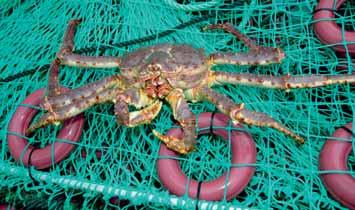
Pacific stocks weak but not overfished
The considerable size of the animals and their excellent taste make king crab a sought-after and valuable fishing resource which has been commercially exploited in the Bering Sea and North Pacific by the USA, Russia and Japan since the 1930s. It was a lucrative business, but one that didn’t last long. After annual catches had risen to around 65,000 tonnes by 1980, yields fell sharply so that fishing in some regions even had to be closed for several years. And today, catches still fluctuate considerably, although according to the latest stock estimates the four king crab stocks in Bristol Bay, the Pribilof Islands, Norton Sound and the Western Aleutian Islands are not overfished. A workshop at which US crab fishermen, scientists and fisheries managers discussed concrete measures to improve stocks in 2006 probably contributed to this. An important aspect here is the rearing of crab larvae in hatcheries to support wild crab populations. These efforts are backed up by a number of research projects aimed, among other things, at increasing our knowledge of crab migration, nutrition and substrate preferences. Another contributing factor is better fisheries management. This is the joint responsibility of NOAA Fisheries, the North Pacific Fishery Management Council and the Alaska Department of Fish and Game.
King crab fisheries are regulated under the Bering Sea Management Plan and must comply with the national standards of the Magnuson Stevens Act and other applicable federal laws.
Although king crab’s natural home is the North Pacific the giant crabs are today also found in the Barents Sea and the European Arctic. The idea of introducing them to that area was born in the Soviet Union as early as the 1930s. Stalin’s forced collectivisation of agriculture had plunged large parts of the country into famine, with the result that some committed biologists were looking for alternative sources of food. They thought that the nutritious and protein-rich giant crabs could perhaps help out here. At that time, however, attempts to settle the crustaceans failed because transport connections between Kamchatka in the Far East and the Barents Sea in the far north were too slow and too unreliable and the young crabs died on the journey. It was not until the 1960s that it was possible to settle the crabs in Kola Fjord near Murmansk. The responsible fishery scientists were convinced that the living conditions in this region of the eastern Barents Sea would largely correspond to those in the Pacific making it possible to build up a lucrative fishery resource that would in addition be limited to the stocking area because the king crabs would have reached the limit of their western distribution due to the prevailing temperature. This was to be a mistake, as soon became apparent.
Between 1961 and 1969, 1.5 million zoea I larvae, 10,000 one- to three-year-old juvenile (almost half males and females) and 2,609 adult king crabs aged 5 to 15 years (1,655 females, 954 males) were released in the Kola Fjord. The new settlers were clearly quite happy with the living conditions in the far north. They hardly have any natural enemies there and their number increased rapidly. Although king crabs are generally relatively faithful to their habitat they moved further west from year to year – contrary to all scientific expectations. Round about 1977 king crabs were found for the first time in Norwegian border waters, in 1992 larger numbers appeared in the south of the Varanger Fjord, and by 1995 breeding populations were discovered in the coastal waters between Vardø and Tana. In 2000 they reached the Lakse and Porsanger fjords and in 2001
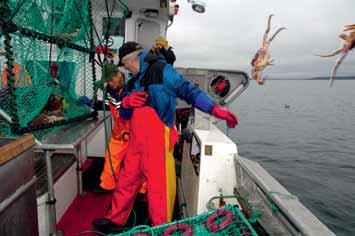
In Norway, king crab fishing is restricted to small boats fishing with baskets in coastal waters within the allocated catch quotas.
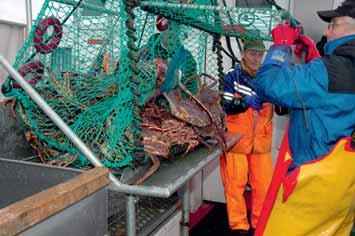
several adult crabs were caught west of the North Cape near Sørøya, a year later even near Hammerfest. We can only guess at what drives the animals further and further west but it is probably the increasing population density and the resulting lack of food in the original stocking area. It is difficult to predict where the invaders’ advance might end. Research into the temperature tolerance of king crab larvae suggests that they could reach the Lofoten Islands. Isolated catches in this area and near Tromsø already show that this is indeed possible.
Crab population spread further west
The living conditions in the Barents Sea are very similar to those in the North Pacific and the Bering Sea, which is why half a century after the initial stocking hardly any differences are recognizable in the biology and way of life of the crabs in the two areas. Furthermore, although the founding population near Murmansk was relatively small, no reduction in genetic variation, including genetic diversity and allelic richness, can be found between king crabs from Pacific and Barents Sea areas. At present, however, there are only few observations of king crabs further away from the coast in the Northeast Atlantic. A further spread in this area cannot be ruled out because the larvae survive higher temperatures than previously assumed. It would be conceivable, for example, that the larvae might advance further north towards Spitsbergen, the first signs of which are already visible off the Russian Kola Peninsula.
An important driver of this development is the available food supply. King crabs will eat almost anything they can find as long as they can prepare “bite-sized” pieces with their claws: Algae, small worms, mussels and barnacles, fish, starfish and smaller species. Since they mainly eat bottom-dwelling organisms, their behaviour has a strong influence on benthic flora and fauna. In areas with a lot of crabs the typical invertebrate species are often absent, especially mussels, echinoderms and bottom-dwelling worms. King crabs themselves are hardly at risk because they have few predators. Occasionally, young king crabs are attacked by demersal fish species, squids, eelpouts, seals or sea otters, but such losses are hardly noticeable in the crab stock with its high reproductive potential.
The females need the wide tail fan to protect the fertilized eggs that they carry beneath it for approximately 11 months.

King crab can apparently adapt to very different environments without major problems. It has a broad food spectrum, is mobile, fast growing, highly fertile and for most of the year lives sociably in groups divided by size and sex. In summer and autumn adult animals move further away from the coast and spend the winter at depths below 200 m.
Life cycle furthers the spread of crabs
In spring the sexually mature crabs migrate towards the coast into shallower waters to mate, spawn or give birth to larvae. The newly hatched larvae are better protected there where they have greater chances of survival in the algae and seaweed forests of the shallow water. King crabs in the Barents Sea are on average slightly larger than their Pacific counterparts when they reach sexual maturity, with shell lengths of about 110 mm. In the course of their lives, female crabs can spawn about 10 to 15 times, with fertility varying between 15,000 and 500,000 eggs depending on body size. This high reproductive potential is an important success factor for adaptation to the ecosystems of the Barents Sea. After hatching, the offspring first pass through a short protozoan stage, followed by four pelagic larval stages (zoea). In this phase of life, which lasts about 60 days during which the larvae feed on plankton, the offspring is carried over long distances by the currents and distributed over large areas. This expansion phase allows the crabs to colonise new habitats relatively quickly. Ultimately, however, the young will only survive where the conditions are favourable.
Towards the end of their larval development the young king crabs give up their pelagic existence and move into a “weaning stage” (megalopa) with which life on the seabed begins. Initially (for about two years) they remain in shallow water at a depth of less than 20 metres which offers them more hiding places from predators. Their shells do not yet provide effective protection, especially as they undergo numerous moults during this phase, after which their bodies are always soft and vulnerable. Even adult animals seek sheltered places for moulting in order to escape possible attacks. Only after two years have the adolescent crabs become so large and robust that they can slowly migrate to deeper water areas. If there is any doubt as to whether the minimum length has been observed the length of the carapace is checked more closely by measuring the length from the eyes to the rear edge of the body.
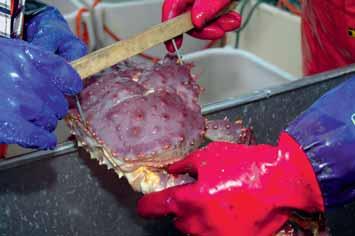
While king crabs in the Pacific have been firmly integrated into natural ecosystems for thousands of years, in the Barents Sea they have been intruders who have only been able to conquer their ecological niche by displacing other species. This has a profound impact on regional ecosystems. Initially, the appearance of the first “monster crabs”, as they were called in some media, was greeted with a pleasant frisson and even considered a “welcome blessing” for the fishing industry, but with the further spread of the species concerns grew, especially in Norway. The crab is now considered an invasive marine species in the Arctic. At the beginning of the 1990s king crabs were already so frequent in some areas of the Barents Sea that their commercial use came to the fore. In 1994 Norway and Russia agreed on an experimental fishery, the annual catch quotas of which were set by the NorwegianRussian Joint Fisheries Commission for the Barents Sea. Since the king crabs form a coherent stock in the area they were managed like cod and other fish species by Norway and Russia together.
Use and limitation of the resource go hand in hand
The phase of joint management ended in 2007 and since then
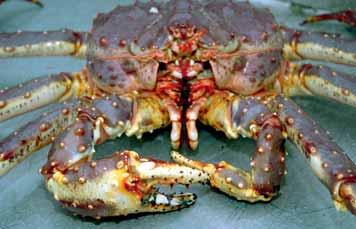
Ideally the muscle meat fills the shell completely (top) while in poorly fed animals or after moulting there are sometimes still “growth reserves” (bottom).
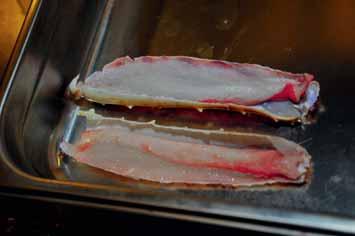

The white, rather fibrous leg meat of the crab is highly appreciated by gourmets all over the world. Complete leg sections are a particularly popular product.
both states have set the permitted withdrawal quantities under national responsibility. The management strategy of the Norwegian Ministry of Fisheries and Coastal Affairs pursues two core objectives. In order to safeguard the long-term economic exploitation of this valuable fishery resource quota-regulated fishing in a limited area is geared to the conservation of the stock. This mainly concerns the Varanger Fjord and the waters of the Finnmark, which are particularly high-yielding in terms of fishing. Equally important is the second objective, which aims to limit the further spread of crabs beyond the fisheries-relevant area. A “free fishery” has therefore been introduced outside the quota regulated area. There the crabs can be caught without a quota and it is forbidden to put viable animals back into the sea. This management strategy seems to be paying off: the crab population in areas outside the quota zone remains at a low level.

With a little practice and skill and despite the tight joints, the muscle flesh can be removed completely from the shell. This is important because the invasive king crabs not only affect biodiversity in the newly populated areas but also cause serious damage to fisheries. They eat bait from the longlines and often nibble on the caught fish, making them unsaleable. In addition, crabs’ prickly bodies get entangled in gillnets, making them unusable. In some areas, king crabs have already decimated the banks of the Icelandic scallop Chlamys islandica, and the coastal population of sea urchins (Strongylocentrotus) has also declined significantly. The accusation that the crabs also feed on the eggs of bottom spawning fish has been partially refuted, since relatively few fish eggs have been found in studies investigating the stomach contents of crabs. It is possible, however, that king crabs are indirectly responsible for the transmission of trypanosomes to cod and other marine fish. The leech (Johanssonia arctica) likes to lay its eggs on the crab shell and this leech is a vector for trypanosomes that parasitize in the blood of many fish species. Studies show that the level of trypanosome infection in cod is significantly higher in areas with the highest densities of king crabs.
In Norway, king crab fishing is restricted to small boats fishing exclusively with baskets in coastal waters and within the allocated catch quotas. In addition, a 3-S regime (Sex, Size and Season) must be observed which primarily permits the capture of males of a certain minimum size during the approved period. Fishing is not permitted during the mating and moulting season.
The allocation of quotas follows the development of the stock. For 2019, for example, the responsible ministry reduced the catch quota for male king crabs by 20 (350 t). This meant that only 1,400 tonnes of male king crabs could be fished, compared with 1,750 tonnes in the previous year. At the same time, the minimum size was raised to 130 millimetres. These allocations apply to the area under quota in the Finnmark east of the 26th degree of longitude which is approximately that of the North Cape. The management measures are intended to limit the currently discernible decline in the king crab population. mk










